In this article, we are going to look at the guide to Google Search Console (Webmasters Tools).
We will try to understand every key, terms, and errors that can appear in the search console.
What is Google Search Console?
Google search console (formerly Webmasters Tools) is a set of tools offered by Google to help web makers to monitor, index, and to improve the website performance for Google search.
It’s very easy to use the new search console, and in this ultimate guide to Google Search console, I will teach you everything from the beginning.
You just need to add your website and start monitoring within a few minutes.
Also, If your website has some loading or displaying issue then you’ll be notified on the search console dashboard.
Its recommended fixing error, warning to improve user experience.

The console provides many different tools to help webmasters:
- Overview: Brief information about the website.
- Performance: Describes how is your website is performing (Clicks, Impressions, Average Position, Ranking Keywords).
- URL Inspection: You can check whether your post is indexed on Google or not.
- Index: It shows the indexing status of all URLs.
- Enhancements: Describes performance, page speed, AMP reports.
- Security: Helps to identify security issues.
- Links: It shows external linking, internal linking, top linked pages, and sites.
- What is Google Search Console?
- How to Add Google Search Console To Your Website?
- Understanding and Installing Sitemap
- How to Add Sitemap to WordPress?
- How to Add Sitemap to Google Search Console?
- Understanding Google Search Console
- Performance Report
- What is the URL Inspection Tool?
- What is Index Coverage Report?
- Sitemaps in Google Search Console
- Speed Reports
- Mobility Usability Reports
- AMP Reports
- Security Issues Reports
- Manual Actions Reports
- Adding Users and Permissions
- How to use Google Search Console – Final Checklist:
- Recommended Read:
Firstly, if you’re running a website then you must signup for search console. Now, I will be helping you to add your website to Google Search Console.
How to Add Google Search Console To Your Website?
Step 1: Sign in to your Google search console account.
Step 2: In the popUp, Click on URL Prefix and paste your website URL.
- If any property is added previously then click directly on add property in the dropdown.

Step 3: Now its time to verify the property. There are multiple ways to verify but I will recommend below two methods:
Using HTML File.
If you’re planning to use HTML file then download the file and upload it to your website home directory.
Using Tags in Head Section.
While using Tags, copy the tag provided by search console and paste it into your website <head> section. You can use plugins to do so.
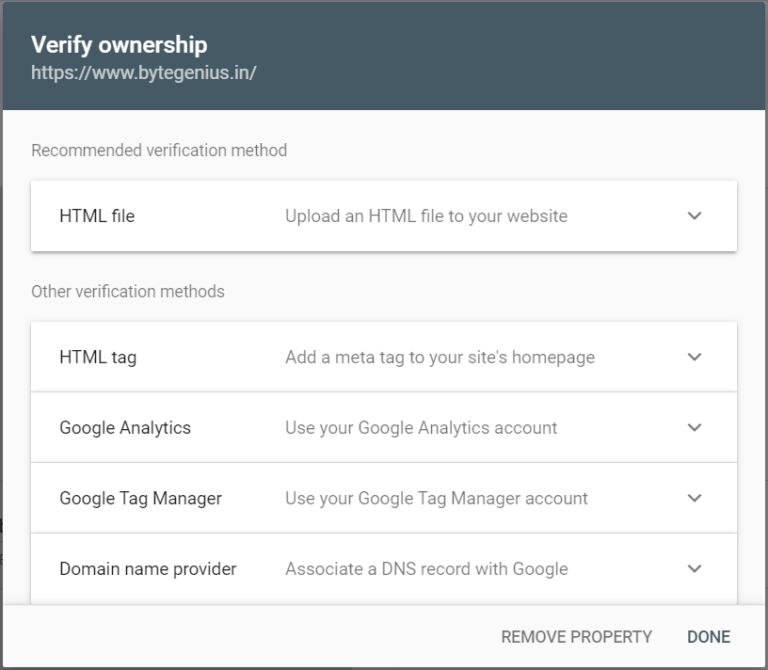
Verification Methods
- HTML file
- HTML Tag
- Google Analytics
- Google Tag Manager
- Domain name provider
WWW or non-WWW version?
Whether you choose WWW or non-WWW version it doesn’t impact the SEO at all.
The basic difference is the display of a website in the search result that’s it. See the below image for reference.

Therefore, if you type bytegenius.in or www.bytegenius.in they both will land you on the same website.
Understanding and Installing Sitemap
Adding sitemap.xml to WordPress is very easy and you can install it within 5 minutes.
What is Sitemap?
Let’s first understand what is a sitemap. So basically, a sitemap is an XML formatted file which contains all your website URL that search engines can crawl.
It also helps search engines to understand the structure of your website and trust me sitemap.xml has an Immense impact on SEO and ranking.
How to Add Sitemap to WordPress?
Its super easy can be done using the Yoast SEO Plugin. I guess you’re using it. Anyways there are many different plugins that can help you to generate a sitemap for your WordPress website.
Step1: Go to Yoast general settings.

Step2: Click on features.
Step3: Set the XML sitemap setting to ON.
Step4: Now click on see the XML sitemap.
In most of the case, Yoast SEO sitemap can be located at {websiteURL}/sitemap_index.xml
That’s it the sitemap.xml is generated and now its time to add it to your webmaster tool.
How to Add Sitemap to Google Search Console?
Step1: Navigate to the sitemap section in the left navigation panel.

Step2: Paste the sitemap URL.
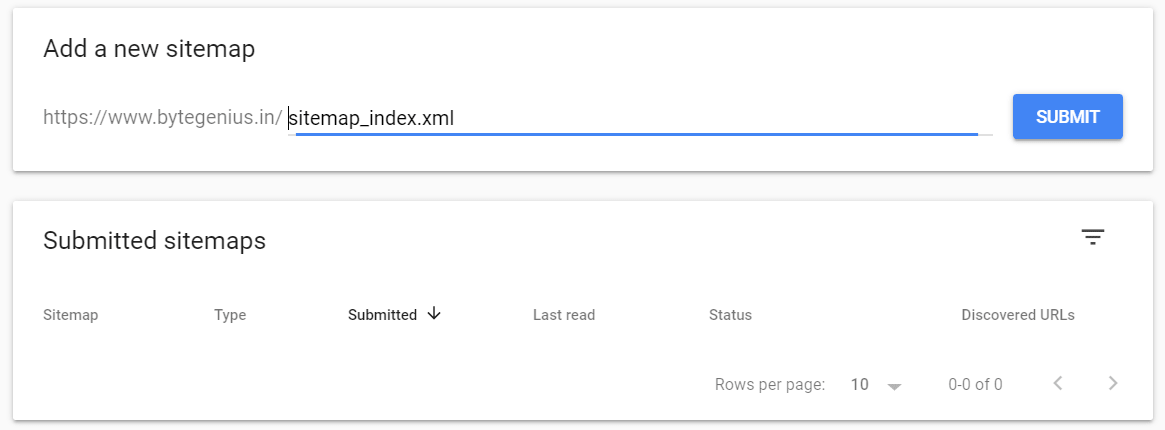
And that’s it. I told you that was easy 🙂
Understanding Google Search Console
Now, we will be going to understand new search console. For a deep understanding of search console, please go through every point and heading that I mentioned below. We will discuss below tools and reports:
- Performance Report.
- URL Inspection
- Index Coverage Report
- Sitemap
- Speed Reports
- Mobile Usability
- AMP Reports
- Manual Actions
- Security Actions
- Users and Permissions
Performance Report
This is a guide to google search console performance report, here you get the overall performance report for your website. You can check how many clicks you get over your website.
Also, it shows the count of impressions, average CTR, and average position of the website at a certain time interval.

What I liked in the new search console performance report is the filter part, where I can see my website performance report for a maximum of the past 16 months. That’s HUGE right?
Also, you can compare the performance report for the last 6 months to the previous period.
Key Definition:
- Total Clicks: How many times the user clicked through the website.
- Impressions: How many times the user saw the website link in the search result of Google.
- Average CTR: Total no of Impression divided by total no of clicks.
- Average Position: The average position of the website in Google search results.
- Queries: It shows the string user searched for and then your website came in the results.
- Pages: Final URL of the website after clicking on the search result by a user.
- Countries: From where the searches came from.
- Devices: Type of devices on a user is searching and getting to your website.
- Search Appearance: It defines the search result whether web or AMP.
- Dates: Group the data with dates.
What is the URL Inspection Tool?
This is my favourite part of Google Webmaster because with this tool you can inspect your website URL whether it is indexed on Google or not. The report includes Indexing issues, AMP errors, and structured data errors.
After getting results Google will let you know whether the URL is on Google or not, AMP related errors, and much more. In fact, you can request FORCE indexing.
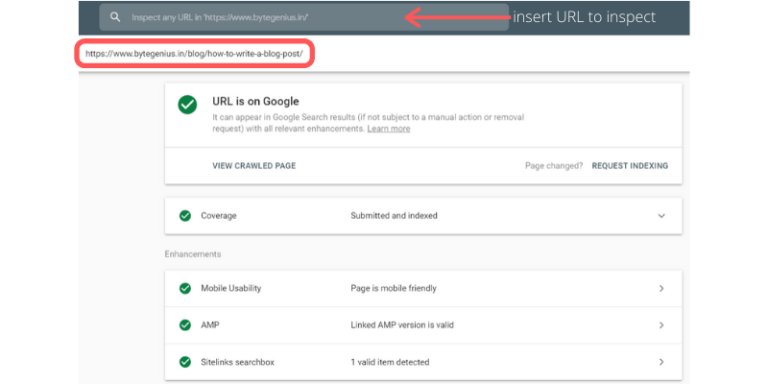
Remember: If the URL inspection tool shows that your URL is not on Google that means the URL will not appear in Google Searches and you can have major traffic loss.
Definitions:
- Coverage: It defines the sitemap information, last crawl date, and more extra information of URL.
- Mobile Usability: It defines whether the URL is mobile-friendly or not.
- AMP: Whether the AMP version of the URL is valid or invalid.
Common Terms In URL Inspection Tool:
- The URL is on Google: It describes that your URL has been indexed by Google and can be shown in search results.
- URL is on Google but has issues: It defines that your URL has been indexed by Google and can be shown in search results but there is some issue in some part of the URL, it might be AMP or something else and you can fix it by google suggestion to avoid bad user experience.
- URL is not on Google: It means that the URL can not be indexed due to some error.
What is Index Coverage Report?
This report shows the overall index report of all URLs. As per Google, this report can be helpful if your website has more than 500 pages else there is nothing to worry about.
In index coverage report you can see no. of indexed URLs, that are valid, invalid or not indexed.
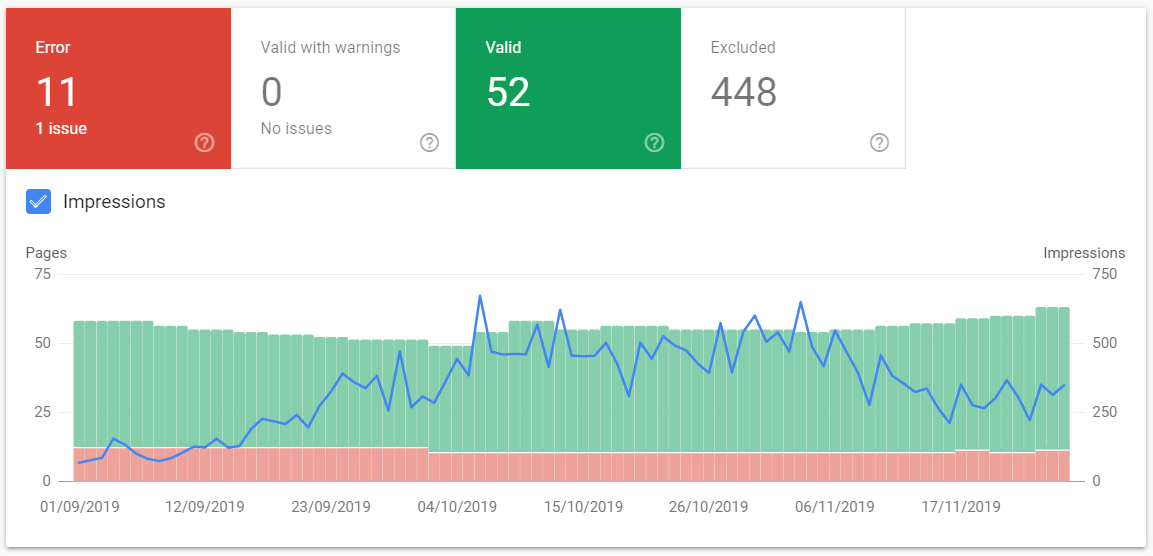
In this report, you can see indexing state of all URLs that Google indexed or tried to index.
Definitions:
- Error: It shows no. of pages that couldn’t be indexed.
- Valid: No. of pages that successfully got index.
- Valid with warnings: Indexed pages with some issues.
- Excluded: It shows no. of pages not indexed intentionally.
Note: Navigate to details section under coverage report for more detailed information.
Sitemaps in Google Search Console
This report helps you to add a new sitemap of your website to the webmaster. Here, you can find all previously added sitemaps and can also add a new sitemap of your website.
Under sitemaps, you can also find:
- Last read of your sitemap.
- Total discovered URL.
- Index Coverage.
Speed Reports
In this report, you can find how fast your pages are loading over the internet.

Do you know, a slow loading website can lead to loss of traffic and high bounce rate. Read some interesting facts below:
- 9.6% visitors bounce back when page loads in more than 2 seconds.
- 32.3% visitors bounce back if page speed exceeds 6 seconds.
- Users visit 5X more pages if page speed is less than 2 seconds.
So always keep your website optimized and try to use a trustworthy hosting provider.
Points to be considered:
- It helps you to discover slow, moderate, and fast URLs.
- Click on reports to see the summary page.
- Click on the URL to see more detailed information.
Mobility Usability Reports
Under the mobile usability report, you’ll find all the URLs if they have some issues while viewing on mobile devices. You can click over a specific URL to see the full report.

Definitions:
- Error: No. of pages with mobility issues.
- Valid: No. of pages that are loading fine on mobile.
Common Terms in Mobile Usability Reports:
- Content Wider Than Screen: This could happen if any image is wider than text or there is a horizontal scroll on your page.
- Text is Too Small to Read: Might be your font size is too small for mobile devices.
- Clickable elements too Close Together: It comes when clickable elements like buttons or links are very close and it is hard to click for the user.
AMP Reports
It is very necessary to have AMP pages on your website because Google index such pages much faster then non-amp pages.
This report can help you to recognize and fix the error that prevents your AMP page to get indexed in Google search results.
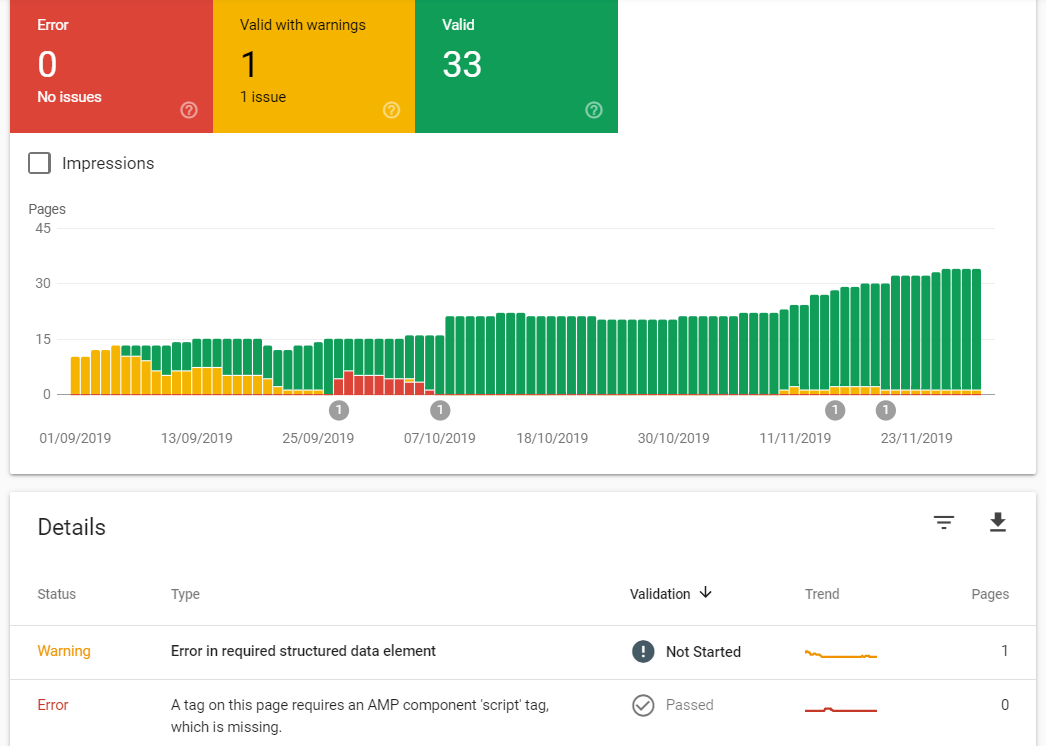
Definitions:
- Error: AMP pages with issues.
- Valid: AMP pages with no issue.
- Valid With Warning: Valid AMP pages with some warnings.
NOTE: Some of the errors are hard to understand and are very long in definitions. In fact, you can click under the details section to get an exact error on your AMP page.
Security Issues Reports
This report will let you know if Google detects any security issue related to your website, whether it can be some hacking issue, malware infection, etc. Some of the issues are listed below:
- Phishing Site
- Malware Infection
- Hacked Type
Manual Actions Reports
So this can be sometimes serious because if your website has some manual actions reported than it can not be indexed and can cause some serious issues.
Usually, manual actions are reported by a human reviewer when your website doesn’t comply with Google Webmaster Policy. Below are some common manual actions that can be reported:
Common Issues:
- User-Generated Spam: If any visitor reports spam on your website.
- Unnatural Links: A bad link coming to and going from your website can lead to such issues.
- AMP content mismatch: It happens when the non-AMP version of the same URL is different from the AMP version.
- Sneaky Mobile Redirects: When a user is redirected to some other page which can be misleading.
Adding Users and Permissions
You can add users and owners to your Google search console account. There are two types of roles.

- Users: A user can see data and change a few settings as per the permission is given by the owner.
- Owners: An owner has full access to the site and can change settings, add other users and owners as well. But I recommend if you’re hiring someone then never give them owners permission because you never want somebody suddenly changes your important settings.
To add Users or Owners navigate to Settings, then click on users and permission. After that, click on add user in the upper right corner and set the permissions.
That’s it for Google Search Console Guide. I hope you enjoyed learning. Share this post and do let me know in the comment section
How to use Google Search Console – Final Checklist:
- Verify your website with Google Search Console.
- Add Sitemap.
- Check the Overview tab.
- Check Website performance.
- Inspect your URL whether it is indexed or not.
- Check your Top performing pages.
- Analyze your ranking keywords.
- Fix errors.
- Start a Mobile-friendly test.
- Remove penalties if any.
I hope this how to use guide to Google Search Console will definitely help you to understand report and errors. Perform the above checklist in order to keep your search engine ranking constant.
